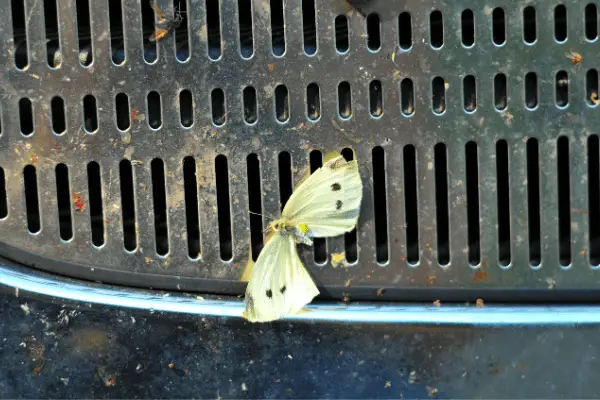If you have a garage, there is a strong possibility that you have opened the door on a summer morning to be greeted by a host of moths fluttering in your face. If this is not annoying enough in and of itself, these pests tend to find their way into your home if the garage is attached to your house. What can you do to get rid of them?
From playing off of moths’ natural tendency to gravitate toward light to creating a cleaner environment that is not conducive to their reproduction, there are 11 steps you can take to get rid of moths from your garage.
1. Invest in an Electrical Discharge Insect Control System
An electrical discharge insect control system, more commonly referred to as a “bug zapper,” is a device that emits an electric discharge that kills flying insects, such as moths, that are attracted to its light. The light attracts moths to an electrical grid, where the moths get electrocuted by touching high-voltage wires.
This device is a more expensive, high-tech version of the light and soapy water trick. It is not going to effectively remove large masses of moths, but it will do an admiral job of getting rid of a few moths to prevent a potential outbreak.
Designed to lure flies, mosquitoes, and other annoying insect pests to the grid where they will be immediately zapped.
If warmer weather is approaching and the moths are likely to start to spawn soon, it may be a good idea to put a couple of these bug zappers at various points on the inside and out of your garage to kill any of the early pests.
When using an electrical discharge insect control system, it is important to keep it clean so that the electric discharge works properly and consistently vacuum the dead moths from the floor of your garage, if not caught by the device itself.
2. Make Use of Cedar
Pheromones are secreted chemicals that are known to influence the behavior or physiology of a certain animal, with pheromones having a particularly strong effect on insects.
Moths are known to be strongly repelled by the pheromones secreted by cedar. Therefore, placing a large cedar stump in your garage is a great way to send moths fluttering for the hills.
Kills moths and other insects on contact.
If the stump is not your style or does not mesh particularly well with your garage’s ambiance, you can regularly spray a cedar solution throughout your garage to achieve the same effect. Simply buy some cedar oil and mix it with water in a spray bottle and go to town. Not only does this solution repel moths, but it provides a refreshing scent to your garage.
3. Use a Pheromone Trap
Just as cedar releases pheromones that repel moths, so too are there pheromones that will attract moths. And just as it is possible to use a moth’s attraction for light to be their downfall, so too is it possible to use their attraction to certain pheromones to be their undoing.
Typically, both male and female moths will secrete pheromones to attract the opposite sex for mating. Scientists have been able to isolate these pheromones and use them for insecticide purposes. In this case, the pheromones are attached to an adhesive strip, and when the moths approach the strip, thinking it is a mate, they stick to its surface and eventually die.
4. Use the Light and Soapy Water Trick
Moths have a tendency to gravitate toward light. If you have ever had a moth problem yourself, there is a strong likelihood that you are familiar with the annoying sound of moths beating their wings against the window as they try to escape into the sunlight. Furthermore, you are also probably familiar with window panes in garages and other outbuildings being caked with dozens of dead moths who could never successfully achieve this end.
Knowing that moths are attracted to light, one of the easiest ways to get rid of a minor moth problem is to use the light and soapy water trick. If you have noticed a few moths starting to flutter around your garage, take the following steps to nip the problem in the bud:
- Make sure that all of the doors and windows in your garage are shut, and everything is as well-sealed as possible
- Fill a large basin with a mixture containing water and dish soap
- Hang a single-bulb lamp several inches above this basin. If you do not have the means of hanging a lamp, try to get the basin situated as close to a single bulb as possible
- Turn off all lights in the garage except the moth-catching bulb
The theory behind this trick is that the moths will aggressively swarm the light throughout the night, and as they hit the bulb, they will bounce off and get stuck in the soapy solution, where they will struggle helplessly for a while before drowning to death.
While this is an effective solution for eradicating a few moths, it is unlikely to be overly effective against large swarms. As such, it is best that you try this trick when you first notice a moth problem and have not let it get out of control. When performing this trick, it is essential that you pay heed to the first step and keep your garage well-sealed so that the bulb does not pull in additional moths from the outside of the building.
5. Vacuum Them Into Oblivion
If you have a significant moth problem, the old light and soapy water trick is not likely to cut the mustard, with more aggressive measures needed for mass eradication.
If this is the case for you, investing in a high-suction shop vacuum can be worth its weight in gold. To rid your garage of mass quantities of moths in a short period, plug in your shop vac and take the following steps:
- Make sure your garage is well-sealed as in the light and soapy water trick, and wait for it to get completely dark. Do not turn on your garage lights until you are ready to start vacuuming
- Simultaneously turn on the garage lights and vacuum. The combination of the light and noise from the vacuum will get them swarming the lights en masse
- Use the vacuum to suck the moths from the air. If you are using a small lamp or have an unsteady light fixture in your garage, just be careful not to cause damage as you follow the moths with the end of the hose
- Once you have gotten all of the moths that are noticeable, be sure to take your vacuum from the garage and empty it somewhere a good distance away, as some moths will find their way back out once the vacuum is turned off. In addition, leaving the moths in the vacuum too long will allow them to drop eggs, not to mention the smell of dead moths can get unpleasant
In addition to sucking live moths from the air, it is a good idea to frequently vacuum your garage floors, as well as the walls and ceilings, if your garage is unfinished. Vacuuming sucks up the dust from which the larvae of miller moths are known to incubate, helping reduce the risk of a future outbreak.
6. Start Turning off Garage Lights at Night in Late Spring
Although many people make it a habit to leave on porch and garage lights in an attempt to deter criminals and trespassers from their property, this may not be the best practice if avoiding moths is your primary concern.
As moths typically begin to spawn with the passing of the cold season, it is a prudent idea to keep your garage lights turned off at night, starting in late April or early May. By leaving your garage lights on overnight, moths are sure to be drawn to the illumination, and the many cracks and crevices for which most garages are notorious are sure to allow at least a handful of moths to find their way inside and once they are inside, the threat of multiplying pervades.
7. Concoct an At-Home Remedy
There are certain herbs that moths cannot stand the scent of, specifically thyme, rosemary, cloves, lavender, and bay leaves. If you dry, crush, and powder any combination of these pungent herbs and hang them in a bag (preferably breathable mesh), it can go a long way toward detracting moth accumulation in your garage.
If hanging these crushed herbs creates too strong an odor for your liking, you can also make a spray, similar to that used with cedar oil, by diluting the essential oils of these herbs and mixing them with water to form a sprayable solution that will not be as concentrated as the hanging bags but capable of being more evenly applied to the surfaces throughout your garage.
8. Frequently Sweep and Vacuum Your Garage Floors and Surfaces
Garages vary wildly in size and scope of use, with many garages being home to luxury cars and others serving as little more than glorified storage sheds. As such, keeping some garages clean and dust-free can be quite the chore. However, no matter the use of your space or how difficult the task may seem, it is essential to keep it as clean as possible, as dust and powder is the incubation site for moth eggs.

One of the best ways to get rid of a species is to take measures to inhibit its ability to reproduce. After all, some species of dinosaurs went extinct because smaller organisms fed on their eggs and prevented young dinosaurs from coming into existence.
Although moths may not be as dangerous as dinosaurs, frequent sweeping and vacuuming of the garage floor can help put an end to their annoying pestilence. Dust the walls and surfaces of any items that have been sitting for an extended period with a disinfectant cleaner as an added measure.
One final note in regard to sweeping and vacuuming the garage floor: some garages are used as a shop for woodworking projects. If this is the case for you, be sure to vacuum the sawdust at the end of each day and empty the contents promptly, as unattended sawdust mounds are a haven in which moths can multiply rapidly.
9. Vacuum Seal Any Clothing to Be Stored in the Garage
Although miller moths are annoying (and disgusting), they do not do much damage other than leave little dust splotches everywhere and pile up in every recess of your garage when deceased.
On the other hand, clothes moths can be a real nuisance, potentially wrecking an entire wardrobe in a single summer by eating through, defecating on, and creating an overall unpleasant musk on your garments.
The problem with these moths is that even if you think you have wiped them out, you are not out of the woods, as it is their larvae that do the real damage. The larvae of clothes moths love to feed on clothing of animal origin, with wool, cashmere, and mohair among their favorite materials. As such, even if you do not detect the presence of any moths in your garage but notice holes being eaten into your clothes, you can be assured that your moth problem is far from over.
If you have already stored some clothes in your garage and detected a moth infestation, you are in for a real chore, as eradicating them from clothes is extremely difficult.
The simplest method is to remove all clothes from your garage and wash them in a hot wash cycle. This is more than likely to kill any eggs or larvae that are embedded in the clothing, but the musky odor is next to impossible to eliminate. When cleaning your clothes, be sure not to leave any of the unwashed clothes in the laundry room or other area of your home where it is possible for the moth eggs and larvae to be transferred to the inside of your house.
If you want to take an extra measure against the spawning of new moths, you can freeze the clothing prior to running it through the hot wash. By keeping the clothing in the freezer for 24 hours, you will kill any living larvae and make the eggs infertile before washing them away in the laundry.
Finally, after ensuring that any larvae and eggs are killed off, or you are simply set to move your clothing to the garage for the first time, store your clothing in a vacuum-sealed storage bag or other airtight container to ensure that new moths cannot sneak into your wardrobe.
10. Check Any Food Items Stored in Your Garage
If you thought that miller moths and clothes moths were the only types of moths to worry about, think again, as the food moth (sometimes called a pantry moth or Indian meal moth) is another threat to infiltrate your garage.

These types of moths are an especially potent threat to those “pantry” foods that are flour or grain-based, such as cereal, pasta, or cornmeal. Therefore, if you buy any of these items in bulk and plan on storing them in your garage until needed, check for the following signs that food moths may be present:
- Small holes in the food’s packaging
- Webbing in the corners of cardboard boxes or recesses of plastic bags
- Any unusual stickiness or clumps
If any of these signs are present, obviously, do not buy the product. However, if you notice them after they are already in your garage, freeze the suspicious products and discard them before the moths can migrate to any other items.
Like with clothes stored in your garage, it is best to put any food in airtight bags or sealed tupperware containers prior to leaving them in storage for an extended period.
11. Fumigation
As a last resort, or if your moth problem is simply too severe to be handled by any of the previous remedies, it may be necessary to have your garage fumigated by professionals. When taking this step, you will likely have to empty your garage of all items so that the pest control experts have access to every nook and cranny where the moths can incubate. From there, they will use a series of chemical sprays and pest control treatments to kill off any moth byproducts.
The downside to this method is that it is expensive and time-consuming, making it likely that your garage is unavailable for a few days as the toxins used to kill the moths are filtered out.
However, It may be worth the investment if you are trying to sell your property, looking to repurpose your garage, or perhaps transitioning it from an unfinished storage space to a more livable area.
Conclusion
Moths in your garage can be an annoying problem that can spiral out of control if left unattended, as moths can quickly reproduce in dust, clothes, and food that is commonly found in garages.
While the best means of controlling moths is to make sure that they are never introduced to your garage, there are 11 possible steps outlined in this article, from using their attraction to light against them to freezing their eggs to calling the pest control experts, that can all help to eradicate these annoying insects from your garage.




